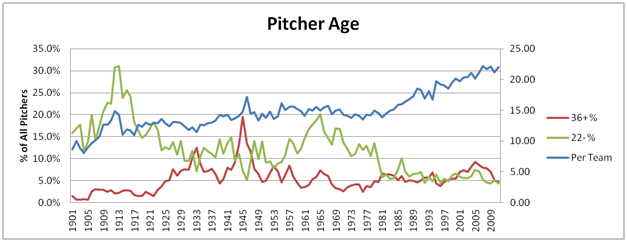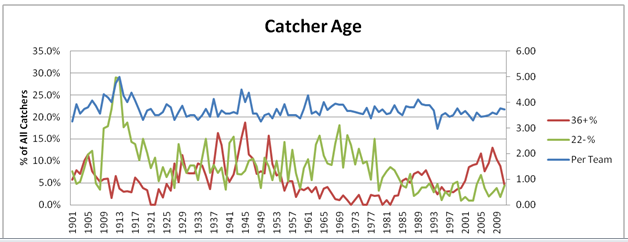In 2011, Jason Varitek caught Tim Wakefield for the final time of their careers. Their combined age was over 84 years. This season, we should see Henry Blanco catch Takashi Saito. Their combined age will be over 82 years. These are just two examples of what I call the “graying of batteries” that has been going on for the past 25 years, and particularly in the past decade. Not sure if you agree? Then consider this:
32% of all “old” batteries (combined age of batter and pitcher over 80 years) since 1919 have occurred in the past 10 seasons. That number jumps to 57% looking at the past 26 years.
If those numbers surprise you (or even if they don’t), why not read some more.
The aging of batteries is depicted in the charts below, showing percentage of pitchers and catchers in younger and older age ranges, as well as the average number of players per team in these positions. CAVEAT ALERT: Note that these numbers are just counts of players and are not normalized for amount of playing time.
The number of pitchers per team held steady around 15 from the end of World War II right up to the early 80s. Since then, it’s been rising steadily until the average number of pitchers per team now exceeds twenty, peaking above 22 in 2009 and 2011. Now look at the percentage of pitchers aged 36 or older. This rate was consistently around 5% in the 80s and 90s, then suddenly shot up, peaking above 9% in 2005, before returning to historical norms the past two seasons. Meanwhile, young pitchers have been declining steadily from their peak during the “bonus baby” days, but have remained steady since the 90s.
So, at the same time the absolute number of pitchers has been rising steadily, so too has the proportion of those pitchers aged 36 and above – ergo, there have been a lot more older pitchers in the past decade.
Now, let’s look at the catchers. Old catchers were virtually non-existent in the 60s and 70s, then shot up into the 5%-10% range in the 80s, dropped back down in the 90s, and finally shot up again in the last decade, peaking above 10% before dropping to something approaching historically normal levels in the past two seasons. Young catchers also were much in vogue in the baby bonus era, but have continued to decline steadily, even from 1980s levels, almost disappearing in the early 2000s, before rebounding somewhat in the most recent seasons. Unlike pitchers, catchers per team has remained pretty much constant for the past century or more, with most teams using 3 or 4 catchers each season.
So, in the past 10 seasons, the absolute numbers of both older pitchers and older catchers has increased significantly. This is reflected in the tables below, showing these old batteries and their last appearance together. Here are the batteries where both pitcher and catcher were over 40 years of age.
Both over 42 years. Only this one battery. Their final appearance was also the catcher’s final career game, as denoted by the bold-face type.
| Game | Combined Age (yy.ddd) | Team | Pitcher | Pitcher Age | Catcher | Catcher Age |
| 2005-07-27 | 84.325 | SEA | Jamie Moyer | 42.251 | Pat Borders | 42.074 |
Both over 41 years. A few more. In particular, two in 3 days for the 2007 Mets.
| Game | Combined Age (yy.ddd) | Team | Pitcher | Pitcher Age | Catcher | Catcher Age |
| 1945-06-05 | 85.083 | BRO | Curt Davis | 41.271 | Clyde Sukeforth | 43.177 |
| 2004-10-01 | 82.346 | MIN | Terry Mulholland | 41.206 | Pat Borders | 41.140 |
| 2007-08-23 | 82.217 | NYM | Tom Glavine | 41.151 | Sandy Alomar | 41.066 |
| 2007-08-25 | 83.021 | NYM | Orlando Hernandez | 41.318 | Sandy Alomar | 41.068 |
And, finally, both over 40 years. The first on this list is the oldest battery by combined age.
| Game | Combined Age (yy.ddd) | Team | Pitcher | Pitcher Age | Catcher | Catcher Age |
| 1930-07-08 | 87.327 | PHA | Jack Quinn | 47.007 | Wally Schang | 40.320 |
| 1989-07-24 | 81.245 | CHW | Jerry Reuss | 40.035 | Carlton Fisk | 41.210 |
| 1992-09-27 | 83.319 | BAL | Mike Flanagan | 40.305 | Rick Dempsey | 43.014 |
| 1997-07-05 | 81.284 | CHW | Danny Darwin | 41.253 | Tony Pena | 40.031 |
So, 11 batteries with both pitcher and catcher over 40, with 4 of the 11 since 2004, and 9 of the 11 in the past 22 seasons.
To fill out the lists above, I’ve also found other batteries with a combined age over 80 years. Those batteries and the ones above (a total of 77) are presented chronologically in the table below. The ranking is from oldest (1) to youngest (77). Click on any of the game or player links to learn more.
Following the table below is another table of the same information. The second table doesn’t have the links, but can be sorted and searched, so you can find all of the batteries for a given pitcher or catcher.
More than half this list is in just the last 26 seasons, since 1986. There have been 25 batteries in just the last 10 years. The other big grouping is 1930 to 1947, with 22 entries in 18 seasons. Some oddities of note:
- Bobo Newsom has appearances on this list separated by 6 seasons.
- Phil Niekro made this list 4 times in his final season, including each of the last 3 games of his career.
- Hoyt Wilhelm similarly had 3 appearances in his final season, and four times after his 49th birthday, even though all of this time was with the same team.
- Wilhelm, Niekro, Jack Quinn, Tommy John and Charlie Hough all pitched regularly all the way through their forties, but none of them made this list until at least their age 46 season.
- Charlie Hough and Carlton Fisk, born ten days apart, were teammates for two full seasons, aged 43 and 44, but never appeared as a battery, even for one hitter. Had they done so at any point in their second season together, they would have been the oldest battery since at least 1919.
- Todd Zeile was catcher in his final career game on the last day of the 2004 season. It was his first game behind the plate in 14 years. Manager Art Howe was “kind” enough to leave Zeile in the game for 8 innings, long enough to catch John Franco (making his first appearance in a month) in what the Mets expected would also be Franco’s career finale. But Franco wasn’t done. He came back the following year with Houston and appeared again on this list in what would actually be his final career game.
- Jamie Moyer teamed up with a pair of old backup catchers in 2009, and with a different pair in 2010. Moyer also has apperances on this list separated by 5 seasons.
- Rick Ferrell and Rick Dempsey appear on this list on consecutive days. Clyde Sukeforth, Pat Borders and Sandy Alomar appear twice in 3 days, Walker Cooper twice in 4 days.
I believe the list above is complete for the game-searchable era. But, if you are aware of one (or more) that I’ve missed, please let me know.
Now, as promised, here’s the same information in a sortable, searchable table. How many of these do you remember? Any surprises, either for the batteries shown or the ones that aren’t?
[table id=20 /]


